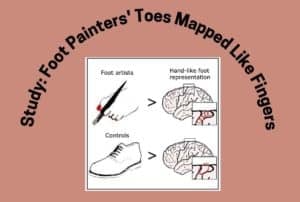Using your feet like hands can cause organized ‘hand-like’ maps of the toes in the brain, never before documented in people, finds a UCL-led study of two professional foot painters.
An extreme example of brain plasticity
These findings, published in Cell Reports, demonstrate an extreme example of how the human body map can change in response to experience.
“For almost all people, each of our fingers is represented by its own little section in the brain, while there’s no distinction between brain areas for each of our toes,” said the study’s lead author, Ph.D. student Daan Wesselink of the UCL Institute of Cognitive Neuroscience at the University of Oxford.
“But in other non-human primate species, who regularly use their toes for dextrous tasks like climbing, both the toes and fingers are specifically represented in their brains. Here, we’ve found that in people who use their toes similarly to how other people use their fingers, their toes were represented in their brains in a way never seen before in people.”
Meet the foot painters
The two study participants are among three professional foot painters in the UK who paint by holding paintbrushes between their toes. They also use their toes regularly for everyday tasks such as dressing themselves, using cutlery, and typing. To do what most people would do with their two hands, both artists typically use one foot for highly dextrous tasks while using the other to stabilize.
Their distinctive experiences extend beyond behavior; by not regularly wearing enclosed footwear, the foot painters get more complex touch experiences on their toes, which may also have impacted the brain development of these organized toe maps.
For the study, the foot painters and 21 people born with two hands who served as a control group completed a series of tasks testing their sensory perception and motor control of their toes.
Brain scans show surprising results
The participants then underwent ultra-high-resolution fMRI brain scanning of the brain’s body area — the somatosensory cortex. While inside the scanner, a researcher tapped the toes of the study participants, first looking for activity in the foot area of the body map.
In the foot painters, specific sections of the brain’s foot area clearly reacted to their toes being touched. Brain maps comprised of individual toes were seen for each artist’s dextrous foot, with a similar but less pronounced pattern showing in their stabilizing foot. The two-handed controls showed no such maps. Other analyses showed the two foot painters’ feet were represented in their brains in a ‘hand-like’ way, but not the control participants’ feet.
The researchers also found that the foot painters’ toes were additionally represented in the part of their brain that would otherwise have served their missing hands.
Perhaps surprisingly, motor tasks showed the foot painters were not any better than controls at wiggling one toe at a time, but they did have heightened sensory perception for their toes compared to controls.
Our brains are not fixed
Peter Longstaff, one of the foot painters who participated in the study, said he was fascinated to learn how his brain developed differently due to how he used his feet. Longstaff, who ran a pig farm for 20 years, turned to foot painting in 2002.
The researchers say the findings reveal that all people may have an innate capacity for forming these ordered maps of each toe in the brain. However, most people’s brains don’t develop as such, probably due to a lack of necessary experience.
“The body maps we have in our brains are not necessarily fixed — it appears as such because they are very consistent across almost all people, but that’s just because most people behave very similarly,” said co-lead author Dr. Harriet Dempsey-Jones.
“Our study demonstrates an extreme example of the brain’s natural plasticity, as it can organize itself differently in people with starkly different experiences from the very beginning of their lives,” said the study’s senior author, Dr. Tamar Makin.
Dr. Makin leads the Plasticity Lab at UCL, seeking to further our understanding of how the human brain is malleable in order to develop ways to tap into the brain’s innate plasticity, which may inform new rehabilitation approaches or treatments for phantom limb pain.
.
.
Edublox offers cognitive training and live online tutoring to students with dyslexia, dysgraphia, dyscalculia, and other learning disabilities. Our students are in the United States, Canada, Australia, and elsewhere. Book a free consultation to discuss your child’s learning needs.
.
.


